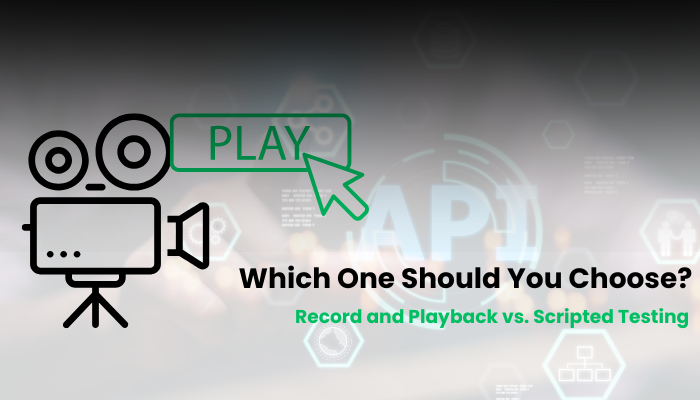Software testing is a critical step in ensuring applications function seamlessly. Among the many techniques available, the debate between Record and Playback vs. Scripted Testing is ongoing. Each method offers unique advantages and limitations, making it essential to choose the right approach based on your project’s specific needs.
In this article, we will explore these two testing strategies in detail, discussing their use cases, benefits, and challenges. By the end, you’ll have a clearer understanding of which approach aligns best with your testing requirements.
What Is Record and Playback Testing?
Record and Playback Testing is an automated testing technique where actions performed on the application are recorded and then replayed to verify its functionality. Testers interact with the user interface, and the tool records their actions as test scripts.
How Does It Work?
- Recording Phase- The tester performs actions like clicking buttons, entering data, or navigating menus.
- Playback Phase- The recorded script is replayed, automatically executing the same steps to validate the application’s behavior.
This method is often used for testing user interfaces and repetitive tasks.
What Is Scripted Testing?
Scripted Testing, on the other hand, involves creating detailed test scripts manually. These scripts outline step-by-step instructions on how the application should behave under specific conditions. Testers follow these scripts to execute tests, either manually or through automation tools.
Key Features of Scripted Testing:
- Predefined test cases
- Thorough documentation
- High precision in covering edge cases
Record and Playback vs. Scripted Testing: Key Differences
When comparing Record and Playback vs. Scripted Testing, understanding their fundamental differences is crucial.
| Aspect | Record and Playback | Scripted Testing |
|---|---|---|
| Ease of Use | Beginner-friendly, minimal coding | Requires scripting expertise |
| Flexibility | Limited customization | Highly customizable |
| Maintenance | High, as scripts may break with UI changes | Lower, with reusable and adaptable scripts |
| Scalability | Best for small-scale tests | Ideal for complex, large-scale testing |
| Precision | Basic validation | Detailed, robust test coverage |
Advantages of Record and Playback Testing
Simplicity and Speed
Record and Playback testing is incredibly user-friendly. Testers can create scripts without any programming knowledge, making it an excellent option for beginners.
Quick Test Creation
Recording test cases is faster than writing scripts manually. This is particularly useful for testing repetitive actions or quick validations.
Effective for UI Testing
This method excels at validating user interfaces, as it closely mimics actual user interactions.
Advantages of Scripted Testing
High Test Coverage
Scripted testing enables testers to account for all possible scenarios, including edge cases and complex workflows.
Customizability
Scripts can be tailored to meet specific testing requirements, making it a versatile choice for projects with unique needs.
Durability and Maintenance
While requiring more effort initially, well-written scripts are easier to maintain and adapt to application changes.
Challenges of Record and Playback Testing
Despite its simplicity, Record and Playback testing has limitations:
- High Maintenance- Recorded scripts often fail when the user interface changes.
- Limited Scalability- This method is best suited for smaller projects with stable UIs.
- Potential for Errors- Recording dynamic content can lead to unstable test scripts.
Challenges of Scripted Testing
Scripted testing also has its own set of challenges:
- Time-Consuming- Writing detailed scripts requires significant time and effort.
- Requires Expertise- Testers need strong programming skills and domain knowledge.
- Initial Setup Costs- The upfront investment in scripting tools and resources can be high.
Use Cases for Record and Playback Testing
Record and Playback vs. Scripted Testing have distinct scenarios where they shine. Record and Playback testing is particularly useful for:
- Prototyping and Quick Tests- Ideal for early development stages when you need to validate basic functionality.
- Short-Term Projects- Effective for small-scale applications with stable user interfaces.
- Regression Testing- Useful for repeating tests on unchanged functionality.
Use Cases for Scripted Testing
Scripted testing is better suited for:
- Complex Applications- Handles intricate workflows and large-scale testing efficiently.
- Regression and Integration Testing- Ensures compatibility across different modules.
- Long-Term Projects- Provides a sustainable testing solution for evolving applications.
Choosing Between Record and Playback vs. Scripted Testing
To make an informed decision, consider the following factors:
Team Expertise
If your team lacks coding skills, Record and Playback might be a better choice. Conversely, a skilled team can leverage Scripted Testing for better flexibility and precision.
Project Scale
Smaller projects with minimal UI changes benefit from Record and Playback. For larger, more complex projects, Scripted Testing is indispensable.
Budget and Resources
Scripted Testing requires more investment upfront, while Record and Playback is cost-effective in the short term.
Tools for Record and Playback Testing
Several tools support Record and Playback testing, including:
- Selenium IDE- A user-friendly browser extension for recording and replaying tests.
- Katalon Studio- Supports both Record and Playback and advanced scripting.
- TestComplete- A versatile tool for functional UI testing.
Tools for Scripted Testing
Popular tools for scripted testing include:
- Selenium WebDriver- A robust framework for creating custom test scripts.
- Cypress- Known for its fast execution and detailed debugging features.
- Appium- Ideal for mobile application testing.
Integrating Both Methods
Instead of choosing one over the other, many teams integrate Record and Playback vs. Scripted Testing to leverage the strengths of both. For instance:
- Use Record and Playback for rapid prototyping and simple validations.
- Transition to Scripted Testing for in-depth testing and long-term maintenance.
Common Mistakes to Avoid
- Over-reliance on Record and Playback- Don’t use it for dynamic or complex scenarios.
- Inadequate Script Maintenance- Regularly update your test scripts to reflect application changes.
- Neglecting Documentation- Detailed documentation ensures reusability and team collaboration.
Future Trends in Testing
The evolution of testing tools and AI-driven automation is bridging the gap between Record and Playback vs. Scripted Testing. Modern platforms now offer hybrid solutions, enabling teams to create robust tests effortlessly.
Afterword
Deciding between Record and Playback vs. Scripted Testing depends on your project’s unique requirements. While Record and Playback is an excellent starting point for quick validations, Scripted Testing offers the depth and flexibility needed for complex, long-term projects. By understanding the strengths and limitations of each approach, you can craft a testing strategy that ensures optimal results.



